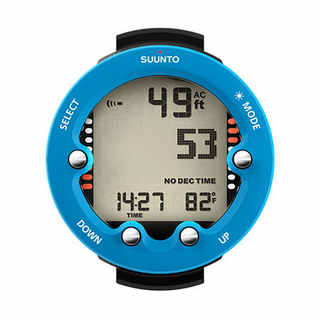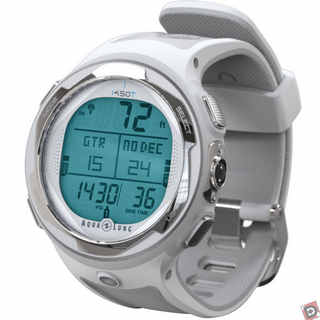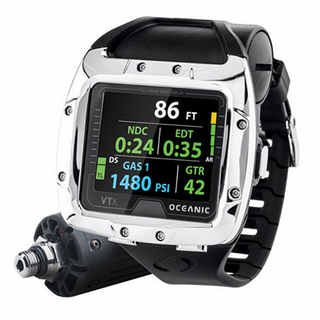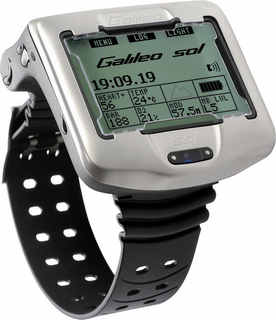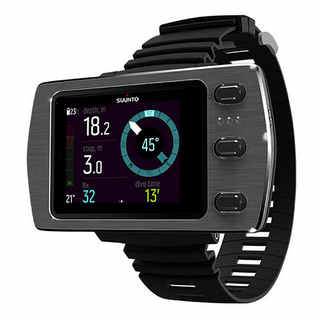Calculating a Healthy AscentContents of this Issue: Life Insurance Quotes for Scuba Divers The Good, the Bad and the Uncomfortable! Your Dive Travel Agent and Frequent Flyer Miles The Failure to Understand Your Computer Your Guide to Conservative Computer Settings Scuba, the Sport of Grandparents! Are Aliens Taking Over Our Oceans? Goodbye Undersea Hunter, Hello Nautilus Undersea The Kosrae Resort Raffle Result Skipperís Remorse at Loss of Diver. Editorial Office: Ben Davison Publisher and Editor Undercurrent 3020 Bridgeway, Suite 102 Sausalito, CA 94965 there arenít any bad computers anymore from the August, 2016 issue of Undercurrent
As you know, the core function of a dive computer is to monitor your likely nitrogen absorption as a function of depth and time, calculate what might be happening to a number of tissue models that might replicate the tissues of your own body and, by an algorithm, calculate the diver's remaining no-stop time, or mandated decompression stops, during a calculated ascent. That's a lot of work. Thank goodness these computers all now use buttons instead of those wet finger contacts of yore when divers went slightly crazy trying to set up their instruments.
Back in the day, I had a lot of fun taking numerous computers on a single rig, diving past 165 feet and comparing how their different algorithms required different ascent behavior. The fun has now been taken out of it, mainly because Bruce Wienke, Ph.D., a program manager at the Los Alamos National Laboratory (LANL), with a serious interest in computational decompression and models, has sold a version of his RGBM adapted algorithm to many different manufacturers. This means many computers now, for a typical leisure dive, perform in virtually the same way. Those manufacturers that have not gone the Wienke-way have adapted or adopted algorithms that give a similar effect, such as a derivation of the Buhlmann ZH-16 algorithm that has been the mainstay of many independent computer makers. These also include Oceanic and Scubapro. Even Oceanic, a company that trod its own path with its Pelagic DSAT algorithm, eventually decided to offer all its computers with two algorithms, letting the diver choose either the Pelagic+, based on Buhlmann ZHL-16C, or the original DSAT. Its sister company, Aeris, which merged with Oceanic in 2014, continued with DSAT. In 2015, Aqualung acquired Pelagic and kept the Pelagic+ algorithm in Aqualung-branded products. Today, in all the computers currently available, the user can adjust them to suit personal beliefs, sometimes in the form of 'gradient' factors. So when it comes to choosing a computer, it's really a question of whether you like its display legibility, whether you prefer its menu, whether you consider it intuitive to use, and whether you like the looks of it. That said, most buyers of diving computers just take them out of the box, strap them on their wrists and go diving with the factory settings. Of course, doing that might be fraught with hazard. Best to read the instruction manual first. Moreover, if you are diving with a second computer as a backup, you need to be sure that both computers are set to the same parameters, or you'll be getting conflicting information. After the dive, you can download the data from virtually all dive computers to your home computer so you can spend long evenings going over depths and times. So, because today's computers do largely the same things, how do you choose between them?
Many of the larger computers have user-changeable batteries, generally with a two-year average life expectancy. Those that double as a watch need to have their batteries replaced by technicians who can pressure test them, a cost that crops up more often than you would expect.
Some bigger computers have colorful displays using OLED (organic light-emitting diode) or TF (thin film) technology. These really help clarify what a computer is trying to tell you. A display in red is obviously crucial, in yellow it's signaling a caution, and green is good. Those with colored displays include the Mares Icon HD4, the HW OSTC, the Atomic Aquatics Cobalt 2, the Suunto EON Steel, the Ratio iX3M Tech, the Oceanic VTX, the Liquivision Lynx, and the Shearwater Perdix. The downside is that illuminated colored displays can use more battery power. (Rechargeable batteries put the onus on the user to remember to recharge them. That's something one might forget during a busy dive trip.)
More and more divers want their computers integrated with their gas supplies so they get all the information needed in one place. This integration can be by hose, as with the Mares Puck Air, Atomic Cobalt 2, Oceanic Pro Plus 3 and Suunto Cobra3, but wirelessly integrated computers are becoming more acceptable. But, oddly, not in the U.S. Doug Krause at Oceanic told Undercurrent that the American diving public was more resistant to this modern technology than elsewhere in the world. Nevertheless, Oceanic, Suunto, Mares and Scubapro (to mention only a few) offer a wide range of computers that will integrate wirelessly with the first stage of a regulator and in certain models with those regulators on multiple tanks. These integrated computers don't just tell you how much gas you have in your tank. They calculate how long it could last at the depth you are diving and with the breathing rate you've demonstrated during the dive. Just keep your remaining no-stop time greater than your remaining airtime and you'll never get into trouble!
Most Undercurrent subscribers are leisure divers, but if you want to use multiple tanks with nitrox, consider the Suunto D6i or Scubapro Mantis M2. If you want to use trimix or a closed-circuit rebreather, consider the Shearwater Perdix, the OSTC, the Suunto DX or Suunto Eon Steel. However, if you don't need this function, why add the extra complication and risk of going into the water with the computer wrongly set up? Many computers can be set for 'gauge' mode where they act simply as a depth gauge and timer (and record keeper), a mode popular with technical divers who prefer to use tables. The sampling rate in 'gauge' mode can be as infrequent as once every 20 seconds. In the free diving mode, a computer samples every second or even a fraction of a second, so if you want to use it for free diving, be sure it has this facility. What do you need? A big display, maybe in color? A watch-sized computer you'll never forget to take with you because it's always on your wrist? Integration with you breathing gas supply? Use with more than one tank during a dive? Able to use it with trimix or rebreather? Do you want to be able to change the battery yourself? If you have a computer with a dual algorithm, be sure it's set to the one that suits your diving style. I haven't attempted to list every computer available. Some are badge-engineered. My own favorites? For simplicity and economy, at $330 the Suunto Zoop Novo is hard to beat. For an easily readable display by an older person plus gas integration, I like the long-established Scubapro Galileo Sol with its intuitive menu, but you must remember to set at least micro-bubble level 1. (It comes out of the box without any micro-bubble setting, i.e., MB0.) It can be found for $1270. For a colorful display without constant fear of the battery going flat, I'd prefer the Shearwater Perdix ($950) or the all-singing, all-dancing Suunto Eon Steel ($1440). If it's a computer watch, the Mares Matrix ($435) has an optional display that looks like a conventional watch.
For example, the German-made Scuba Capsule 6, combined with an iPhone 6 or iPhone 6S and the app supplied and downloaded, makes a great diving computer with a full-color display, it's nitrox and trimix-compatible, and it works in conjunction with Suunto tank transmitters. It doubles as a digital compass, map atlas, with GPS (at the surface) and gas planner, too. Not only that, but you can also take photographs with it during the dive, while keeping essential dive information as a head-up display! Expect to pay around $500, plus another $350 for the wireless tank transmitter. (iPhone not included.) Remember, no dive computer manufacturer can guarantee you won't suffer an incident of decompression sickness (DCS) caused by scuba diving. Read the manual and fully understand it before you go diving. -- John Bantin |

I want to get all the stories! Tell me how I can become an Undercurrent Online Member and get online access to all the articles of Undercurrent as well as thousands of first hand reports on dive operations world-wide
| Home | Online Members Area | My Account |
Login
|
Join
|
| Travel Index |
Dive Resort & Liveaboard Reviews
|
Featured Reports
|
Recent
Issues
|
Back Issues
|
|
Dive Gear
Index
|
Health/Safety Index
|
Environment & Misc.
Index
|
Seasonal Planner
|
Blogs
|
Free Articles
|
Book Picks
|
News
|
|
Special Offers
|
RSS
|
FAQ
|
About Us
|
Contact Us
|
Links
|
3020 Bridgeway, Ste 102, Sausalito, Ca 94965
All rights reserved.

